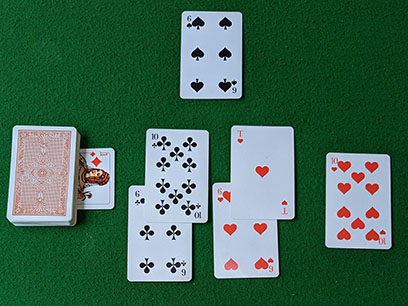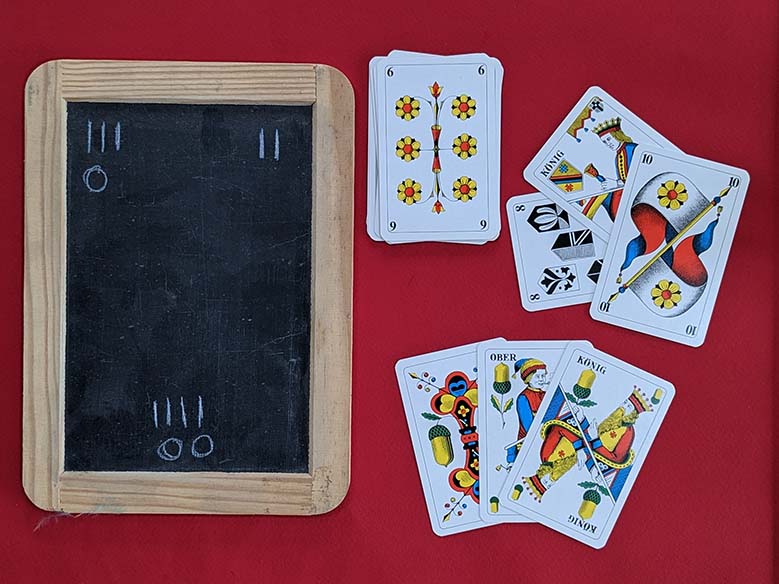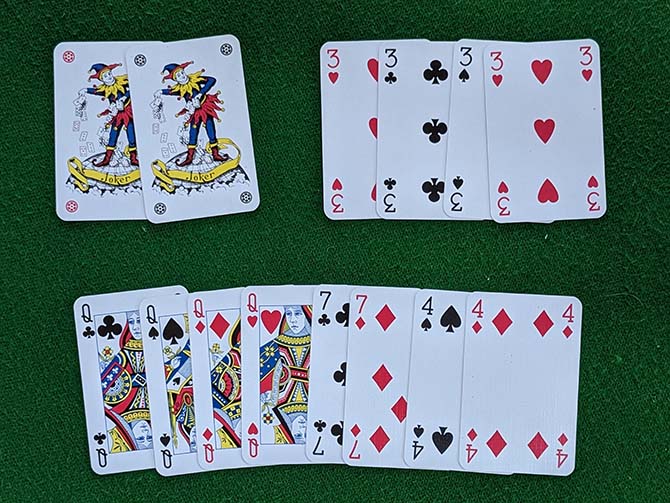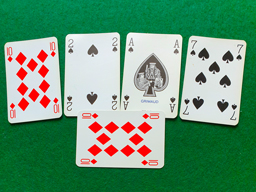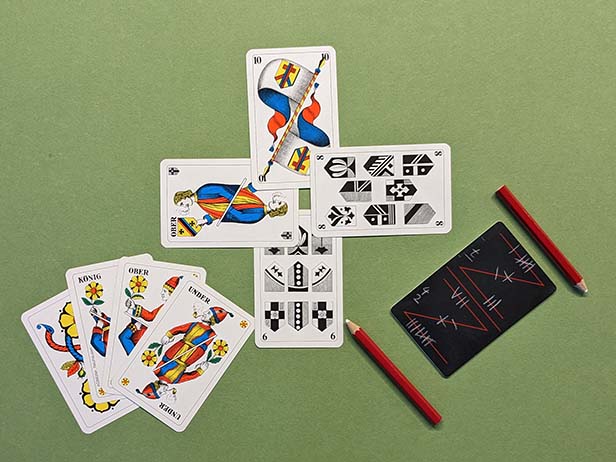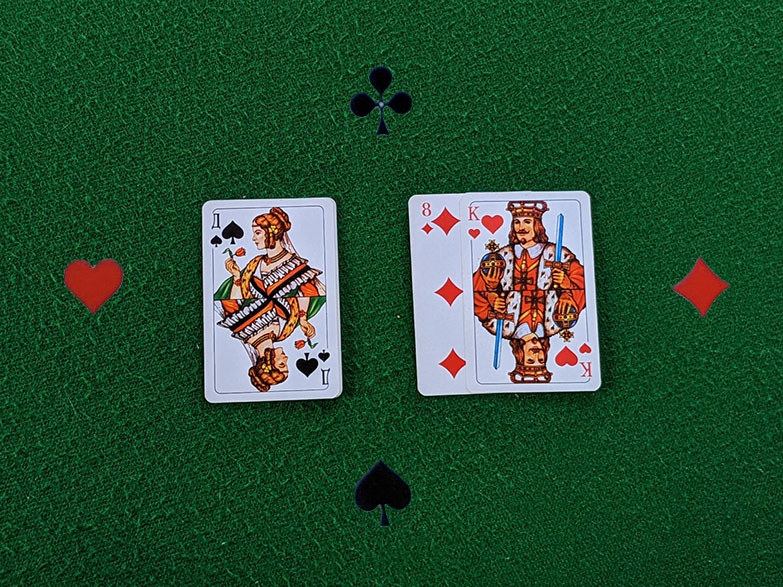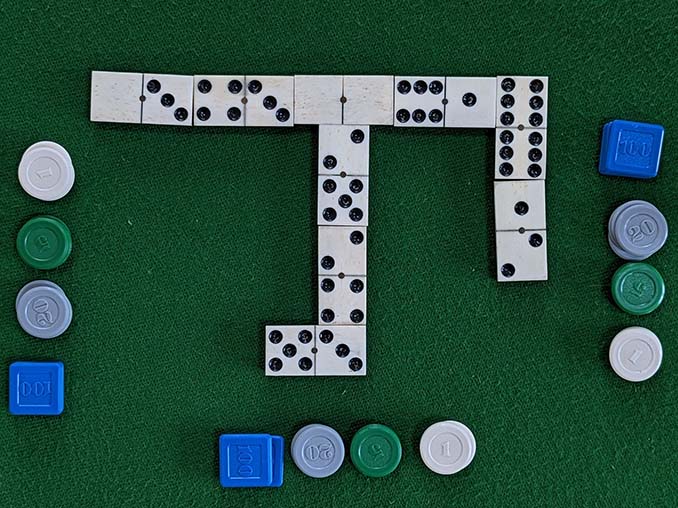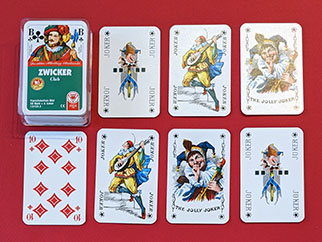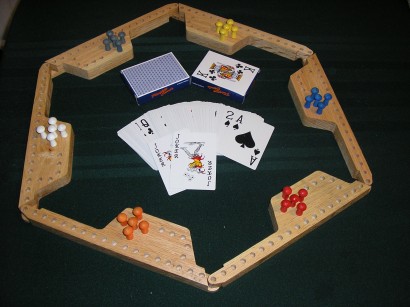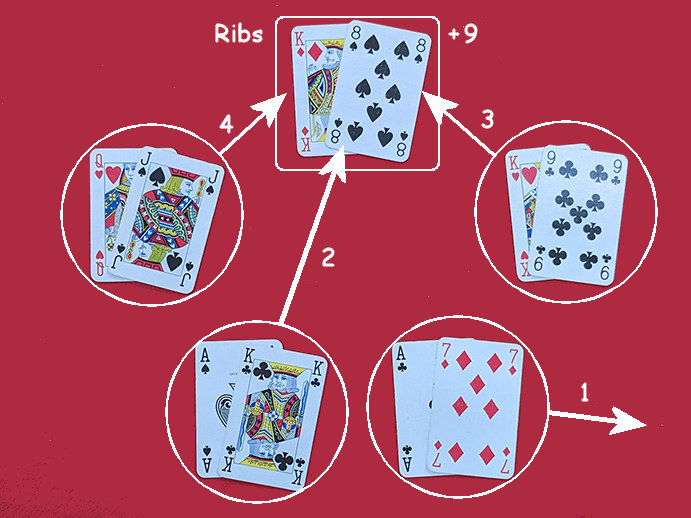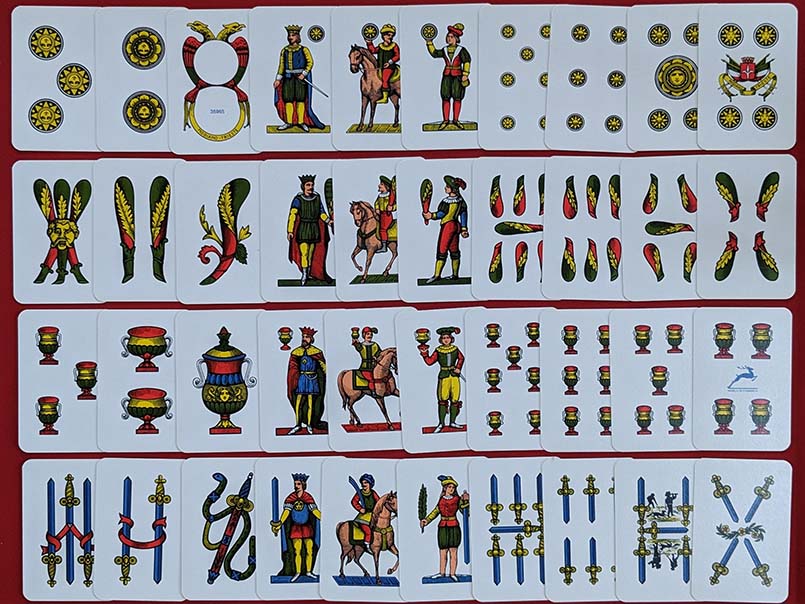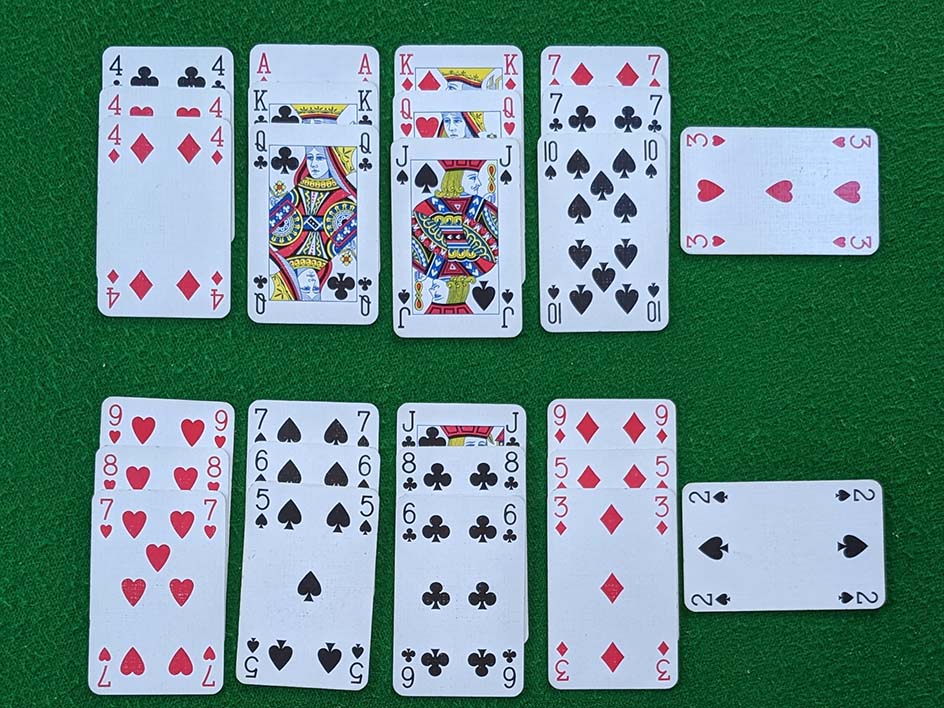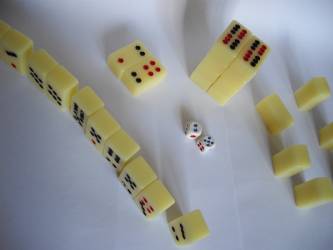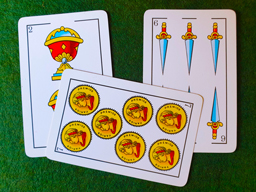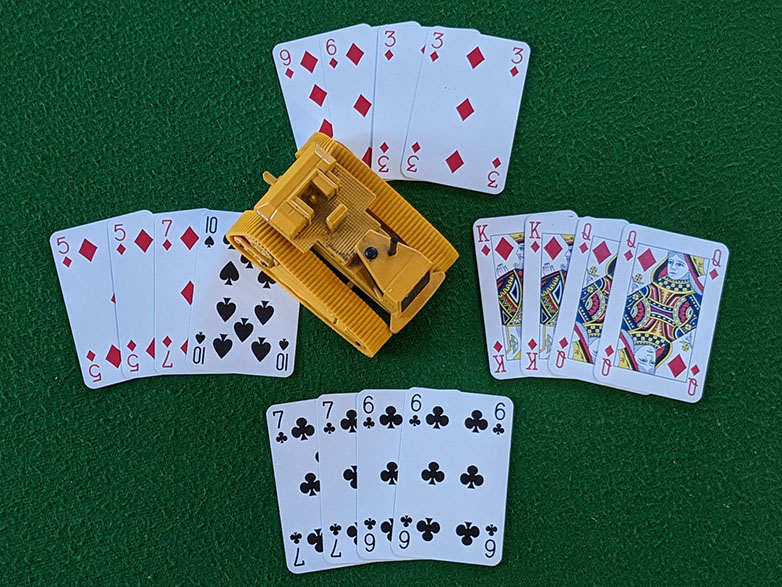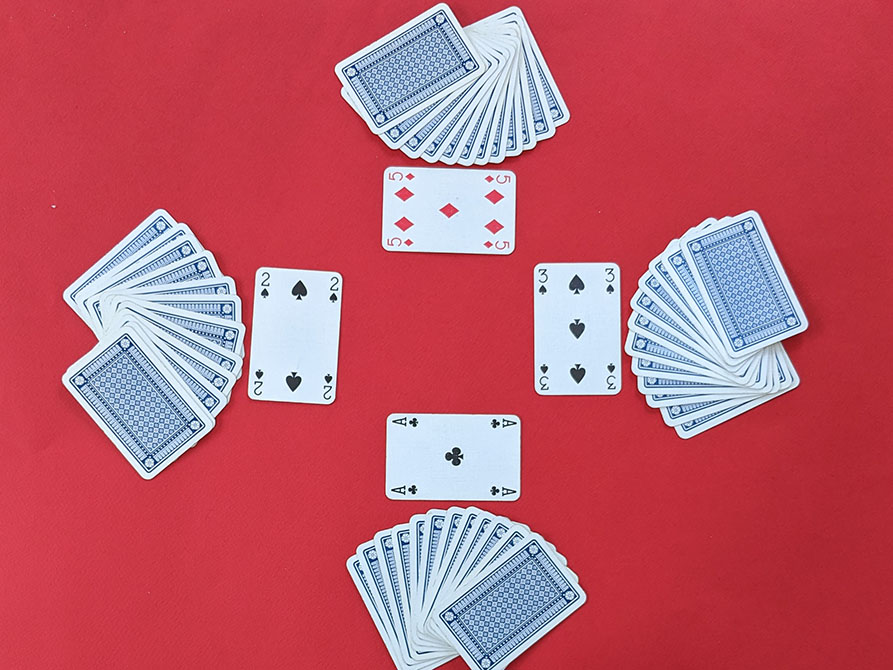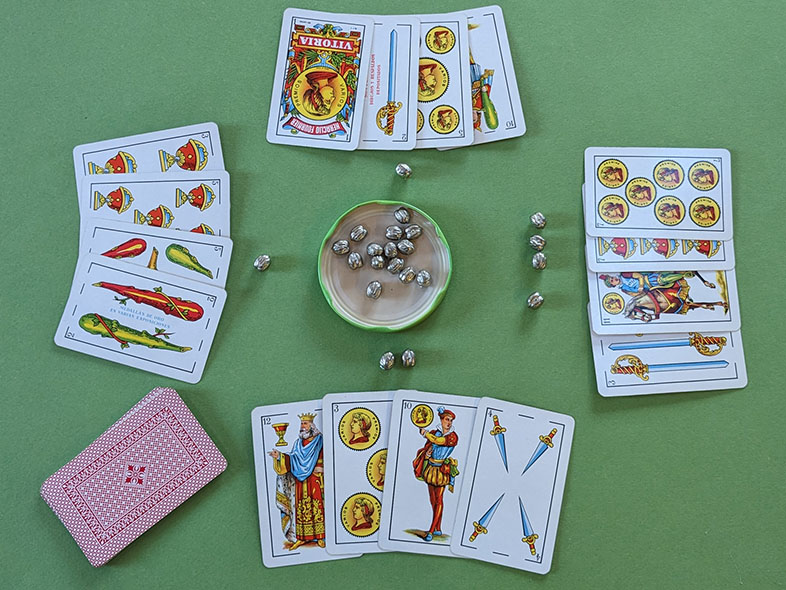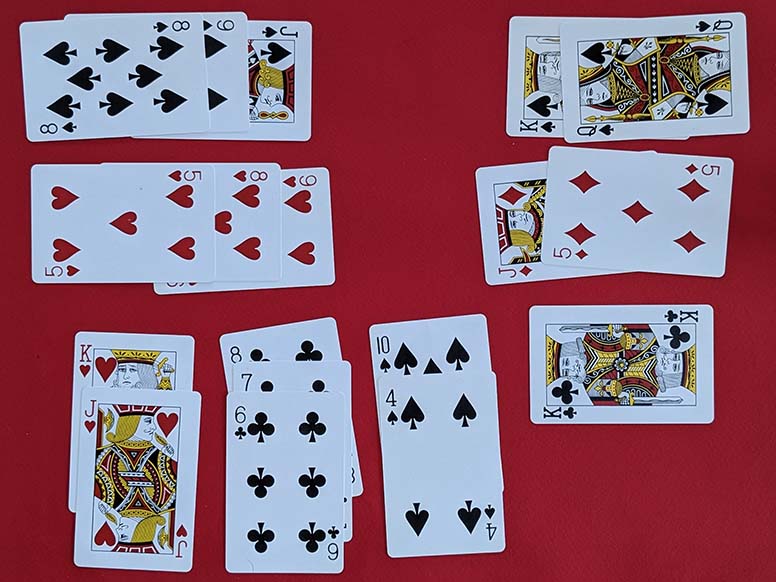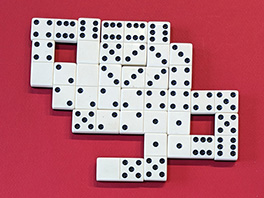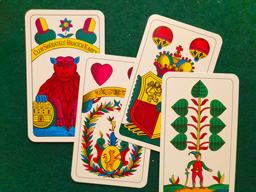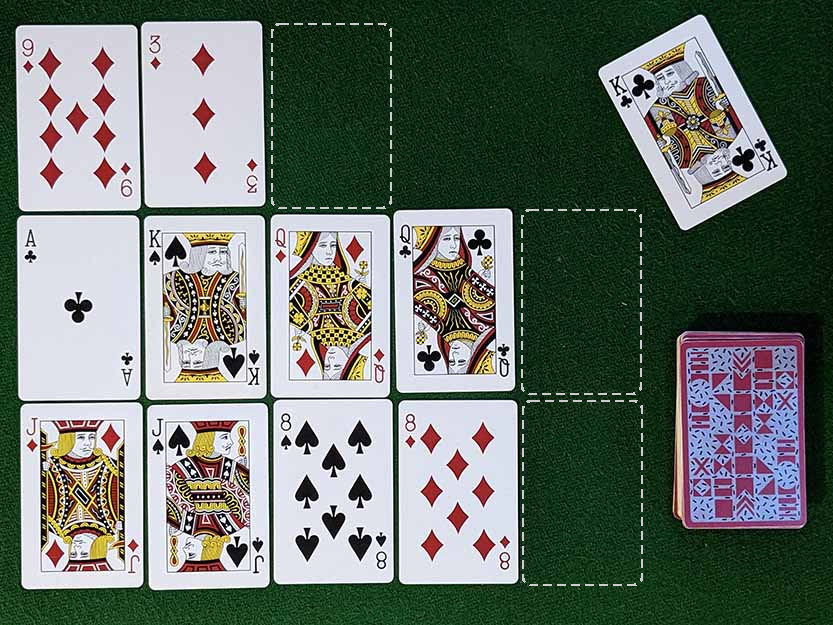Recommended Games for Four Players
A selection of some the best 4-player card games and domino games, recommended by the editor. For a longer list of traditional games, see the full 4-player game index. See also our recommended games for two, three, five and six players.
World famous partnership trick-taking card game with bidding to determine the trump suit and minimum number of tricks to be won.
Lively game from the Netherlands, often played for drinks. There are no trumps and the aim is to win the last of four tricks, or to bet that you can win it and convince the other players to fold.
Durak is one of the best known card games in Russia and has spread to many east European countries. It can be played by 2-6 people and works well for 4 playing as partners.
Over the past 50 years, Tarot has become one of the most popular card games in France, played at home, in clubs and in regional and national tournaments.
Scopone is a skilful Italian four-player partnership game in which cards or sets of cards are captured from the table by playing cards of equal value.
This four-player trick-taking game, played in and around Poznań in Poland, uses just 16 cards - the aces, tens, queens and jacks of a standard pack. It's not a simple game, but once you know how to play it, it is very quick.
An enhanced version of Hearts played in China in which penalty cards can be exposed in advance to double their effects and with special roles for the Jack of Diamonds and Ten of Clubs.
An unusual draw and discard game from Nepal, which has also become popular in Israel. Players get rid of their cards by discarding rummy-like combinations which they have collected.
A Swiss game for up to 4 players. Also known as Sackjass, Butzer or Schläger Jass, this is generally considered the most basic form of the Swiss national game Jass.
Austrian Tarock game for 4 with a large choice of contracts. In some the bidder plays alone, in others the bidder chooses a partner by calling a king.
In this 4-player tarot game from Hungary partners are chosen by calling the XX and there are multiple objectives including catching the XXI and winning the last trick with the I (pagat ultimo).
This Chinese climbing game has become very popular in the last 20 years. One player volunteers to play alone as the 'landlord' against the other players in partnership. Playable combinations include the bomb (four of a kind), the rocket (complete set of jokers) and the quadplex set (four of a kind plus two single cards or pairs).
Popular game from Ecuador for 2-4 players in which equal cards and sequences are captured by matching or addition from a layout on the table.
This Swedish game for 2-6 players is a reverse form of Casino. There are penalty points for playing a card that captures a matching card or set of cards from the table, and a large penalty for clearing the table.
Indian trick taking card game for 4 players in fixed partnerships in which the aim is to capture tens. Cards played to tricks are only captured when the same player wins two consecutive tricks.
A Nordic game for up to 7 players in which the aim is not to win the last trick. When playing to a trick you must either overtake or play your lowest card.
Catalan trick-taking game for 4 players in partnership. The very strict rules of play allow many deductions about the location of cards.
Finnish partnership game for 4 players. A point-trick game with bidding in which the trump suit is set or changed by declaring marriages.
Four-player partnership version of the Swiss national card game. It is a point-trick game with some extra points for declarations, in which you may play a trump to any trick even if you have a card of the suit led.
This climbing game from Jiangsu Province in China is for four players in fixed partnerships. It is particularly well balanced with many opportunities for strategy and partnership co-operation.
Russian game in which you must either beat the previous player's card or pick up cards from the play pile. The last player holding cards is the loser. Good for 4 players: each has their own trump suit.
Watten is a sociable game from Bavaria and the Tyrol with many opportunities for bluff. It is best for 4 players but also playable by 2 or 3. The South Tyrolean variant 'Blind Watten' in which trumps are chosen secretly is especially interesting.
This popular 4-player game from north Germany is played with a double deck of 2×24 cards. The players with the queens of clubs are partners, but you only find out who your partner is during the course of the play.
An enhanced version of the popular Swiss card game Schieber Jass for four players in partnerships. In Sidi Barrani there is an auction to determine the card points target for the bidders and the trump suit, Obenabe or Undenufe.
This Tyrolean trick-taking game featuring combinations, wild cards and bluffing has been recognised by UNESCO as an item of intangible cultural heritage.
In this unusual version of Casino played in Eswatini and Lesotho, players can steal cards from the top of their opponents' capture piles to help with building piles for later capture.
Dutch domino game for 3 to 5 players in which after the deal the loser of the previous hand chooses the rules from a large range of options: ordinary or matador matching, single line or cross, and various extra conditions can be selected.
This four-player fishing game from Schleswig-Holstein has great scope for strategy and partnership cooperation. It features high value jokers and building by subtraction as well as addition.
North American partnership race game for 4, 6 or 8 players in which cards are used to move pegs or marbles around a (normally home-made) board.
Unusual game for 4-10 players from Cleveland, Ohio in which cards are played two at a time, and before each trick players bid according to the number of points they think they can capture.
Famous Italian card game for four players in partnerships, in which Threes are highest, Aces are most valuable, and there are no trumps.
British game for four or fewer players in which players choose how to divide a 13-card hand into four 3-card Brag hands and an odd card. Each player's hands are ordered best to worst and the corresponding hands are compared.
Tibetan domino game for 4 players using a double set of Chinese dominoes (64 tiles). Tiles are played in tricks, singly or in groups, and the main aim is to win the last trick.
Spanish fishing game with 40 cards for 2-4 players. Cards are captured by making sets that add up to 15.
In this unusual Punjabi game for 4-8 players, the aim is to get rid of cards. If anyone is unable to follow suit, the 'winner' of the trick has to pick up the cards played to that trick. There is scope for skill, but it also works well for a group that includes inexperienced card players.
A special form of Tarock played in southern Baden, Germany featuring a large talon. Many of the contracts require the bidder to discard all or nearly all the cards they were dealt and play with the talon cards instead.
Chinese partnership trick-taking game for 4 or 6 players in which pairs and sequences of pairs can be played and the aim is to take Kings, Tens and Fives.
Indonesian game for 4 players. Bid for tricks by placing a card from hand face down. Suit of highest bid determines trumps. Objective is to win or lose tricks depending whether bids add up to more or fewer than the 13 available.
Lively and popular Brazilian partnership game for four players. The aim is to win two of the three tricks, and the score for this can be increased by betting during the play.
Traditional round game for 4-8 players in which players try to get rid of their cards by playing them in ascending sequences of up to 5 cards in suit. There is a second version in which equal ranked cards are played.
This popular 4-player Spanish game of betting and bluffing is unusual among vying games, in that it is played without money and with partnerships.
A distant relative of Bridge played in Finland. Skruuvi is a sophisticated descendant of the Russian game Vint featuring misere bids and passing of cards between partners.
A popular Belgian trick-taking card game for four players with objectives and partnerships determined by the bidding.
An original game in which players try to manage their cards, to play as many cards as possible of each suit in descending order - invented by Mitch Gunzler. See also the variation known as Mitch.
A two-dimensional domino game for four players by Clark D. Rodeffer, in which points are scored for matching adjacent dominoes.
A relative of Canasta which has become immensely popular in Italy since the 1990's. There are 4 players in partnerships, both runs and sets can be melded, and each team has a third hand to be used when a player runs out of cards.
A Swiss descendant of the medieval card game Karnöffel, for 4 or 6 players in partnerships.
Popular Czech game for 2 or 4 players in which tricks are won by playing a card equal to the lead or a seven. The objective is to capture aces and tens.
Although this rather new game is based on poker hands and became popular with poker players in 2012-2013, there is no bluffing or escalating betting. Players compete to build poker hands using cards that are seen by all players.
This four-player partnership game with 40 cards, combining features of Briscola and Tressette, is popular in Venice and the surrounding region.
This well-known 4-player Indian partnership trick-taking game is distantly related to the European Jass family, with the jack and nine ranking high in all four suits.
A 4-player compendium game with 7 contracts: each player must play each contract once. It was enhanced in the 1960's by Bridge players who introduced doubles which create loose alliances between players with a common interest.
A four-player partnership game played in the Punjab and some other parts of India. It is related to Royal Casino but with greater scope for skill because all the cards are dealt at the start.
A dutch Jass game that works well for 4-6 players. If you play and win twice you are out of the game and safe. If you play and lose twice or are the last player in, you buy the drinks.
The above are the editor's recommendations, but tastes differ and you may find other games you like more in the full index of traditional 4-player games. Further 4-player games can be found among the collection of invented games and on the commercial games page.
Explanation of symbols
Difficulty. Subjective assessment of the editor combining two factors: how difficult or complex the rules are, and how difficult it is to learn to play the game well.
Popularity. Games are ranked in order of the average number of people (actually different IP addresses) per month who visited the game rules page in the last 6 months. Top 10% get 5 hearts, next 10% 4 hearts, next 20% 3 hearts, next 30% 2 hearts, bottom 30% 1 heart. (The top 6 games under this ranking are also listed on the home page as 'most popular games'.)
Trend. The number of visitors in the most recent month are compared with the average per month over the preceding five months, and the significance of the change is estimated using a statistical technique described here. The pages are then ranked in order from most significant increase down to most significant decrease. The top 10% are given 5 flames, the next 20% 4 flames, the middle 40% 3 flames, the next 20% 2 flames and the bottom 10% 1 flame. (The 6 games or pages with the most significant increase are also listed on the home page under 'recent interest'.)
The stats and popularity/trend ratings are updated at the beginning of each month, and the order in which the recommended games are listed on this page is shuffled randomly once a week so as not to give undue weight to any one recommendation.
Notes on four-player games
A group of four players has the widest choice of excellent card games, hence the large number of recommendations on this page to which many more could easily added. One big advantage of this number of players is that games can be played between two equal teams of two. A popular arrangement is for each player to sit opposite their partner, but there are other interesting possibilities including variable partnerships (or 'alliances') determined by bidding or by the locations of particular cards. Some games also feature alliances of three against one, and of course there are also games in which each of the four players play for themsleves.
Although the initial information available to a player who sees only one quarter of the cards is typically less than when there are only three players, extra information can often be gained through bidding, announcements and declarations, and during the game players may make useful deductions from their partner's and opponents' choices of play.
Another format that should not be overlooked is where each player in turn sits out of a deal and takes a short break while the others play. This is a well-known feature of Bridge in which one of the players is a 'dummy' who lays down thair cards to played by their partner. But there are also many three-player games that work well with four players at the table, only three of whom participate in each deal. Here are some of our recommended three-player games that are suitable for this treatment:
- Alsós: An elaborate Hungarian trick-taking card game for three players combining features of Klabberjass and Tarok, which was very popular in the early twentieth century. There are also versions for two or four players.
- Ulti: The national card game of Hungary, a trick-taking game for 3 players using a 32-card pack: 10 cards each and 2 in the talon. Each bidder takes the two-card talon and discards two cards which can be used by the next bidder.
- 1000: This 3-player 24-card game is popular in Eastern Europe: Russia, Ukraine, Belarus, Poland and the Baltic States. It is a point-trick game with extra points for marriages, which change the trump suit when declared.
- Calabresella: Italian three-player point-trick game with bidding. The main aim is to capture aces (the third highest cards of the suits) and take the last trick, which is difficult to guarantee since there are no trumps.
- Vira: An elaborate Swedish trick-taking game for 3 players featuring a wide selection of possible contracts, in which players can improve their hands by drawing cards from the stock.
- Tarok (Danish): The Danish version of Tarok is a 3-player game with 78 cards, closely related to the version formerly played in Germany and sometimes known as Grosstarok. The main aim is to win the last trick with the lowest trump (the Pagat) or a King.
- Skat: National card game of Germany, a game of tricks and trumps for three players using 32 cards. Players bid to decide who will play alone against the other two, aiming to take the majority of the card points.
- Tresillo: Modern Spanish form of the classic 3-player game Hombre, the first card game that featured bidding to decide who would choose trumps and play alone. To win, the bidder must take more tricks than either opponent separately.
- Go Stop: A popular Korean game for 2 or 3 players using flower cards. Having collected enough scoring combinations to win, you have to decide whether to stop the game or try to improve your score at the risk of losing everything.


